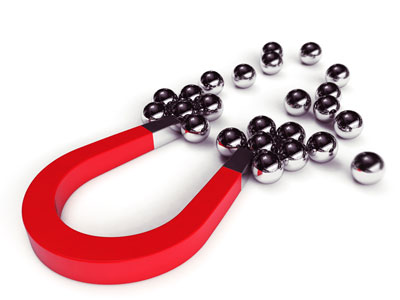What do magnets do?
How does this align with my curriculum?
Have fun discovering what magnets can pick up in this hands on activity.
What You Need
- 1 magnet
- Items that will attach to a magnet (paper clips, screws, items made of iron, nickel, or steel)
- Items that will not attach to a magnet (paper, plastic, aluminum foil, etc.)
- Pencil (optional)
- Piece of paper (optional)
Safety First!
Some smaller items can be choking hazards for young children. Choose appropriately sized objects.
What To Do
- Explore the items list above to see which ones will or will not be attracted to the magnet.
- Sort the items into 2 groups, based on the object’s ability to attach to the magnet.
Discovery
The magnetic field surrounding a magnet is a type of force. The force is the result of the magnet having a north pole at one end and a south pole at the other end. The north pole is attracted to the south pole, creating the magnetic field surrounding the magnet.
Magnets attract only objects made of iron, steel, nickel and cobalt. When a magnet comes close to an object made of these materials, the object is pulled by the magnetic force surrounding the magnet. If close enough, the object will attach to the magnet.
Magnets are used in many different things, such as televisions, trains, compasses and decorating your refrigerator!
- Find other objects around your home that are attracted to the magnet. Be careful not to touch a TV or computer screen with the magnet as it could damage them.
- Create a chart of the items that are, or are not, attracted to a magnet. This could be done with pictures, words, or both.
- Test different magnets to see if some magnets are stronger than others. For example, find out how many paper clips each of the magnets can pick up. Sort your magnets from strongest to weakest.
For more information on this topic check out these Let's Talk Science resources:
- Magnificent Magnets (Lessons) - Magnets are fun! Explore the many shapes and sizes of magnets and the objects that are attracted to them in this lesson.
- Design & Build a Toy That Moves (Lessons) - Do you know a lot about magnets? How would you design and build a toy that is moved using forces applied by magnets?
What’s happening?
The magnetic field surrounding a magnet is a type of force. The force is the result of the magnet having a north pole at one end and a south pole at the other end. The north pole is attracted to the south pole, creating the magnetic field surrounding the magnet.
Magnets attract only objects made of iron, steel, nickel and cobalt. When a magnet comes close to an object made of these materials, the object is pulled by the magnetic force surrounding the magnet. If close enough, the object will attach to the magnet.
Why does it matter?
Magnets are used in many different things, such as televisions, trains, compasses and decorating your refrigerator!
Investigate further
- Find other objects around your home that are attracted to the magnet. Be careful not to touch a TV or computer screen with the magnet as it could damage them.
- Create a chart of the items that are, or are not, attracted to a magnet. This could be done with pictures, words, or both.
- Test different magnets to see if some magnets are stronger than others. For example, find out how many paper clips each of the magnets can pick up. Sort your magnets from strongest to weakest.
For more information on this topic check out these Let's Talk Science resources:
- Magnificent Magnets (Lessons) - Magnets are fun! Explore the many shapes and sizes of magnets and the objects that are attracted to them in this lesson.
- Design & Build a Toy That Moves (Lessons) - Do you know a lot about magnets? How would you design and build a toy that is moved using forces applied by magnets?
